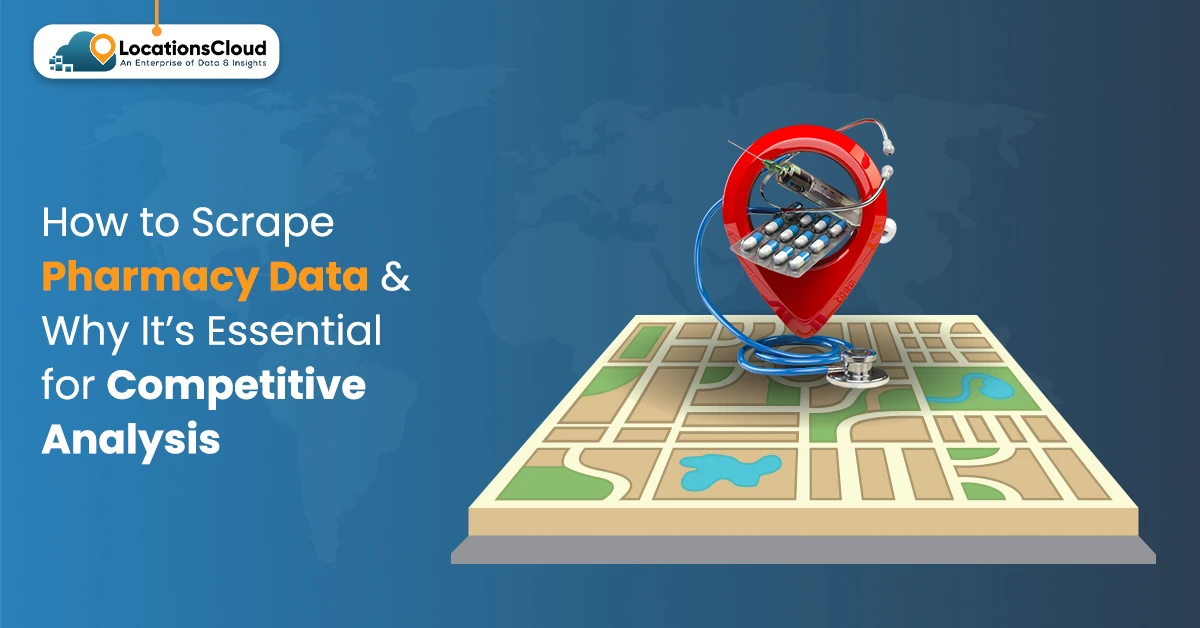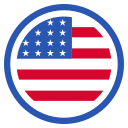
The pharmaceutical industry is rapidly moving towards digitization. With many patients using online pharmacies and healthcare platforms alike, the publicly available information on medicines/prices/customer experiences has never been greater in volume and breadth. For businesses, there is now the challenge and opportunity to sift through all this information to get insights that can help inform better business decisions, especially to gain an edge over competitors.
Pharmacy data scraping is the answer. The processes around scraping pharmacy locations have opened up collections of structured data from pharmacy websites around prices, inventory, and shopper sentiment, while revealing larger market insights—the value of pharmacy scraping increases when combined with location intelligence, providing essential context for competitive analysis. Consequently, businesses can gain insights not only into the pharmaceutical industry but also regarding where these developments are occurring and their underlying reasons.
In this blog, we will look at how pharmacy data scraping contributes to competitive analysis, how it integrates with location intelligence, and how businesses can leverage insights from pharmacy data scraping to inform better strategies in a fast-evolving digital healthcare environment.
What is Pharmacy Data Scraping?
Pharmacy data scraping is the automated procedure used to collect structured data from pharmacy websites, e-commerce retailers, and marketplaces. Scraping allows companies to aggregate massive volumes of pharmacy data in real-time, and instead of having to collect product information and pricing data manually, it does that for you.
Pharmacy data could include:
- Product Data: brand names, generic names, dosage forms (tablet, capsule, syrup), strengths, active ingredients, manufacturers, classifications, and prescription status.
- Pricing Data: retail and wholesale prices, discounts, offers, cost per unit, bundles.
- Availability & Inventory: product availability, out-of-stock and backorders, availability trends.
- Pharmacy Data: store names, locations, and contact information.
- Customer Data: ratings, reviews, sentiment analysis on products, and other user feedback.
- Market Trends: different seasonal patterns in demand, product launches, and new therapeutic categories.
Pharmacy data scraping transforms unstructured web data into structured data for analysis. This process enhances our understanding of patient behavior, identifies more efficient supply chains, and clarifies the competitive activities of sales representatives.
Ultimately, this benefits manufacturers, healthcare providers, insurers, and brokers, as well as marketing, sales, and field market researchers.
Why It’s Essential for Competitive Analysis
| Challenge | How Pharmacy Data Scraping Helps |
| Constantly shifting prices and shortages | Tracks market dynamics by monitoring pricing trends, drug shortages, and new product launches. |
| Competitors offering better deals or availability | Benchmarks against competitors to compare products, pricing, and customer sentiment. |
| Inconsistent supply across regions | Identifies market gaps where certain medicines are unavailable, enabling smarter distribution. |
| Need to remain competitive on pricing | Optimizes pricing strategies with real-time monitoring and adjustments. |
| Pressure to innovate | Informs product development and marketing by analyzing patient reviews and demand trends. |
Location Intelligence: The Geographic Dimension of Pharmacy Data Scraping
Pharmacy data scraping becomes immeasurably more beneficial when combined with location intelligence. Location Intelligence not only provides dimension to the raw data, but adds the “where” element to your numbers to create actionable insights. As an example, prescription and availability can vary dramatically in price and demand changes based on region, city, or even neighborhood. With pharmacy data scraping tied into the geographic context, pharmacists can address important questions like:
- Where are drug shortages more common?
- Which cities have costlier prices for the same generic medicine?
- How does the demand between urban and rural pharmacy patients vary?
- What sort of geographic patterns are visible in consumer reviews and satisfaction?
Consider a pharmaceutical distributor discovering that allergy medicines frequently sell out in larger cities but remain overstocked in smaller towns. With the inclusion of location intelligence, the distributor could pull their inventory from the overstocked philosophy and redistribute it elsewhere to stay ahead of market trends.
As stated here, location intelligence takes pharmacy scraping to a true competitive advantage for hyper-local strategies able to respond to specified market questions.
How Pharmacy Data Scraping Ties into Location Intelligence?
Location intelligence isn’t simply the act of mapping data – it’s putting data in a geographic context to understand the patterns that remain invisible without spatial context. Enriching the geospatial context of a pharmacy data scrape will yield:
- Compare drug prices by country, city, or state to identify regional pricing discrepancies.
- Identify seasonal or environmental influences on medication demand for specific areas.
- Identify areas of high pharmacy density and potential underserved markets.
- By scraping pharmacies in multiple countries, there is the opportunity to observe variance in pricing and availability in various regulatory environments.
- Sentiment can be analyzed geographically; consumers in one area may prioritize low-cost options, while consumers in other regions may prioritize brand trust over cost.
What Are The Location-Specific Scraping Methods?
Geographic-based scraping demands a differentiation in methods to capture location-centric information:
- Geo-Targeted Proxies will give scrapers the ability to behave like users from a specific place to gather local pharmacy information (local pricing, local offers).
- Region-Specific Keyword Optimizations refer to making regional alterations to scraping queries based on casual language norms and specific search terms.
- Multi-Region Normalization of Data can also occur after scraping, meaning all scraped data needs to be normalized across geographies.
- Store-Level Scraping goes beyond scraping national pharmacy websites. Businesses are scraping local pharmacy chains and independent pharmacies to gather location-based information.
How to Scrape Pharmacy Data?
Data scraping pharmacy data is a structured process. Here’s the general workflow:
- Identify Data Sources: Figure out the pharmacies, online marketplace, solicitors or healthcare platform which you are going to scrape.
- Scraping Plan: Before you get started on rolling the tools data. you will have to pick the fields of data you want to scrape from the following list. Which can be in any combination of: product, price, stock, reviews, or location.
- Anti-Scraping Controls: You will have to consider going into this process scraping pharmacy data if the web page which you are scraping has anti-scraping controls in place.
- Obtain or Scraped Data: If you have scraped and collected structured data that can be arranged in a form of structured data either CSV, Excel or JSON formats, then for any JSON or XML files, it is much easier to be run than de-compile.
- Cleaning and Validation: Cleaning is where you standardize your naming conventions, drop duplicates, and confirm consistency and validity.
- Analyze and Visualize: Depending on your skillset, you can use R, Excel, or any Business Intelligence (BI) software to uncover price trends, regional pricing insights, or shifts in customer sentiment based on stars for pharmacies!
Future Outlook: The Digital Pharmacy Revolution
Today, the pharmacy business is entering a digital revolution. As consumers utilize the internet to refill prescriptions online, purchase over-the-counter drugs and leverage telehealth consultations, scraping becomes essential.
- A tighter identity of location intelligence: Belief in the importance of geography is paramount to align supply chains with regional demand;
- AI-enabled scraping: Automated systems will identify discovery of new data sources, reconfigure to protect against anti-bot strategies, and return with better insights, faster;
- Regulatory change: Governments will likely introduce prescribed guidelines on the duties of an online pharmacy which may require compliant scraping;
- Personalization of healthcare journeys: The scraping of consumer reviews and availability will deliver hyper personal experiences to patients.
Pharmacy data scraping is more than a technology process; it is a crucial pillar of the digital pharmacy transformation.
What Is The Role of Location Intelligence in Pharmacy Data Scraping?
We re-engage with location intelligence to regain relevance. Geographic context is necessary for pharmacy data scraping to be complete. In a scenario where the pharmacy only has pricing, availability, and sentiment data, the “where” is missing. A drug may be cheap in one city and expensive in another. A supply shortage in rural areas may suggest weaknesses in the supply chain, not demand issues. Variance in consumer sentiment, by geography, could be indicative of either cultural or regulatory bias.
By supplementing pharmacy data scraping with location intelligence, businesses have complete, actionable, and relevant market intelligence.
Conclusion
Data scraping pharmacy websites for competitive analysis and competitive intelligence in the healthcare industry is critical to strategic planning and analysis in the fragmented pharmacy industry. Data scraping pharmacy websites also expands the possibility of using structured data to extract live data on product assortments, pricing, inventory, and purchasing intentions, enabling companies to modify their plans relentlessly in the competitive pharmacy world. But it is the fact that we can couple scraping and location intelligence that captures insights on geographic pricing, demand, and consumer psychology.
Whether a company is trying to make that leap, there is an enterprise-grade web-scraping infrastructure combined with a complete location intelligence infrastructure in LocationsCloud. Whether you benchmark the price of a drug in editors’ market areas, try to see if demand is shifting for that drug, or identifies a new market, LocationsCloud can help turn basic pharmacy data into insights for you to make better choices on behalf of your pharmaceutical company for growth, in a healthcare world demanding more digital first solutions.


